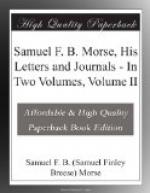I have incidentally mentioned the caveat in the preceding chapter, but a more detailed account of this important step in bringing the invention into the light of day should, perhaps, be given. The reports in the newspapers of the activities of others, especially of scientists in Europe, led Morse to decide that he must at once take steps legally to protect himself if he did not wish to be distanced in the race. He accordingly wrote to the Commissioner of Patents, Henry L. Ellsworth, who had been a classmate of his at Yale, for information as to the form to be used in applying for a caveat, and, after receiving a cordial reply enclosing the required form, he immediately set to work to prepare his caveat. This was in the early part of September, 1887, before he had met Vail. The rough draft, which is still among his papers, was completed on September 28, and the finished copy was sent to Washington on October 3, and the receipt acknowledged by Commissioner Ellsworth on October 6. The drawing containing the signs for both numbers and letters was attached to this caveat. Having now safeguarded himself, he was able to give his whole mind to the perfecting of the mechanical parts of his invention, and in this he was ably assisted by his new partner, Alfred Vail, and by Professor Gale.
The next few months were trying ones to both Morse and Vail. It must not be supposed that the work went along smoothly without a hitch. Many were the discouragements, and many experiments were tried and then discarded. To add to the difficulties, Judge Vail, who, of course, was supplying the cash, piqued by the sneers of his neighbors and noting the feverish anxiety of his son and of Morse, lost faith, and would have willingly abandoned the whole enterprise. The two enthusiasts worked steadily on, however, avoiding the Judge as much as possible, and finally, on the 6th of January, 1838, they proudly invited him to come to the workshop and witness the telegraph in operation.
His hopes renewed by their confident demeanor, he hastened down from his house. After a few words of explanation he handed a slip of paper to his son on which he had written the words—“A patient waiter is no loser.” He knew that Morse could not possibly know what he had written, and he said: “If you can send this and Mr. Morse can read it at the other end, I shall be convinced.”
Slowly the message was ticked off, and when Morse handed him the duplicate of his message, his enthusiasm knew no bounds, and he proposed to go at once to Washington and urge upon Congress the establishment of a government line. But the instrument was not yet in a shape to be seen of all men, and many years were yet to elapse before the legislators of the country awoke to their opportunity.
Morse and Vail were, of course, greatly encouraged by this first triumph, and worked on with increased enthusiasm.
Many years after their early struggles, when the telegraph was an established success and Morse had been honored both at home and abroad, he thus spoke of his friend:—




